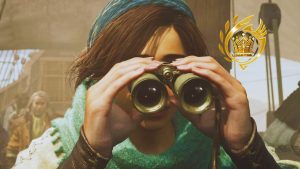Five games in two years; 15 in five. That’s the type of output that independent studio Strange Scaffold has had. From action-packed titles like El Paso, Elsewhere to the tense atmosphere of Clickolding, Strange Scaffolding’s clear mission is to make games that players don’t necessarily know they want or need. Insider Gaming was able to sit down with creative director Xalavier Nelson Jr. for an exclusive interview to talk about Strange Scaffold and their new game I Am Your Beast.
You can read the interview in full below or watch/listen to it via our YouTube channel.
Strange Scaffold Interview with Xalavier Nelson Jr.
Where is the time coming from to create all these different types of games?
Nelson Jr: It’s just different priorities. I remember when a game studio, even say from software would launch one, two, three games a year, Activision, if you look back 10 years back in, or even at this point, 20 years back to like 2004, Activision would publish something like 20, 30 games in a year. Now they update their live service games and they might have one or two.
And those changes in how we release and make games and the priorities we have along the way, a single game, partially because it keeps getting updated, has to generate more revenue, which means more microtransactions for players, which means more exploitative game loops that get you caught up in this being the one game you play, all those things have an impact on the developers, but very much also the player experience.
When you change the process, you change the project and Strange Scaffold, we’re just trying to provide people with the next game they didn’t know they needed. And those priorities, those very player centric thing of, you didn’t know you needed a dark fantasy horror kidnapping sim.
So here it is. Here’s an open world comedy adventure game, entirely stock by stock photos that makes most of the people who play it cry. Here’s a game that brings back Max Payne, because we haven’t done that. No one, we’re bringing back the boomer shooter, which is great, but no one’s bringing back Max Payne, no one’s bringing back those classic third person shooters. We make games in a different way, which lets us explore games with different priorities and bring new things to the table. So Clickolding into I Am Your Beast is one of the clearest, I think, examples of when we release I Am Your Beast, we’ll have released 15 games in five years.
And it’s just because we want to make sure that players are seeing something new and exciting on a consistent basis. And even if it makes less money than a Fortnite, knowing that at this point, we’re one of a smaller group of people exploring that territory means that we kind of have to do it. Otherwise, the medium of art and experiences that I love becomes more and more like hash machines in digital form.
How do you come up with the different premises for these games?
Nelson Jr: At this point, it’s mostly my brain, although something I really believe in is making sure that the way the game is developed allows a lot of other people to bring their voices into it to make it better than the sum of its parts.
A lot of the best pieces of El Paso elsewhere, because a level designer inspired by the vision and direction of the game did something weird or Romero Bonicaus in the primary programming design collaborator I had on the project said, hey, can we do this? That’s where the wall bounce came from. He was like, hey, I found a bug, but I want to keep it. Is this OK? And he jumped and he bounced off of a nearby wall because of a change we had made in the movement code.
So he had basically found a way to basically do a double jump with a with a combat dive, getting more air to take down enemies while you’re falling in slow motion. I said, no, that’s it. That’s it. That’s in.
And that’s where I think auteurship, there’s a lot of discussion that’s happened around it in film and in games. I think that’s where auteurship can be at its best is when it can provide something so strong that it facilitates other people to do things. But yeah, the the the ideas do mainly come from my head. And a lot of it is saying both what is a thing that can be made? Yes, but also what makes it make sense, because a game like click holding, unless it has a very specific scope and efficiency of design, it doesn’t make sense to make it. No one is coming into twenty twenty four saying one of the sensational horror games of the summer is going to be the game where you click for a guy in a click chair.
Creating games that can tell a story or accomplish a goal?
Nelson Jr: The idea that regardless of that specter, if it was haunting my nightmares, I wouldn’t make a game about that character or that world unless I also knew exactly what we were trying to accomplish with it and how it provided value to a player’s life.
I think it’s why strange scaffold stands out, because there’s people who make games very quickly. There’s people who make there’s a lot of people who make really high quality games. But the fact that we’re saying, hey, efficiency and quality are not opposing sides of the spectrum.
They are just one there. They can be taken as one way to facilitate making experience you never could otherwise. It’s something that means a space warlord organ shredding simulator gets made in the first place, because if you’re just looking for how to maximize profit or what’s selling right now, you don’t have the tools to find your players next favorite game, which is one of the interesting things about how our ultimate set of partnerships came about for that game was we had pitched Space Warlord to a lot of people and everyone either stalled the conversation or was just like, I’m not sure about this.
Then we did our own reveal trailer and because we were like, you know, we’re not going to. We’re not going to wait for the rest of the industry to catch up to us, we did it for Dog Airport game. We were talking about development from the beginning.
And so for Space Warlord, we tried to go dark and do things the right way. It didn’t do anything special. So we were like, screw it.
We’re going to we aren’t going to let the rest of the industry, especially since we can’t finish it under our own power. We’re going to let them determine whether or not this game gets made. And we put our own announcement trailer.
And suddenly all those people are writing back and we end up eventually on things like Game Pass, but only after we had kind of stepped out front and proved this is a game that deserves to get made. Oh, you feel weird about organs? Oh, no. How will players not like that? You have to show it to them in the first place.
We are as an industry in a place where people are terrified to even give players something to like, let alone dislike. Yeah. What if it’s not like Lethal Company? What if it’s not like Civilization? What if it’s not like Change Together or whatever is the current du jour of the industry? So, yeah, I give a lot of props to my fellow developers.
And I think there’s a lot of amazing work still being done in the medium. It is contrary to what some commentators might say. It’s not a hotbed of exploitation, even for projects with really messed up microtransaction models. There’s a lot of developers who love players who are doing good work on those projects and trying to do their little part to make experiences better.
But Strange Scaffold, we have managed to carve out a place for ourselves where we work so efficiently that the rest of the industry can’t tell us no. And I’m very thankful for that because we kind of ended up here by accident.
What was the inspiration behind I Am Your Beast?
Nelson Jr: A lot of it was, again, kind of seeing gaps where the rest of the industry was either not following down a path or it’s determined that a path wasn’t worth following anymore. Like things like Max Payne and debt to rights in the Die Hard trilogy on PS1 for the real OGs out there. And for I Am Your Beast, it was looking at, OK, a lot of people are going into this tactical space, that kind of Tom Clancy early 2000s era Splinter Cell Ghost Recon space and satisfying the nostalgia there.
But that’s kind of where the conversation and the thought process stops. We have a lot of games that are emerging that are following down the same paths. And the paths are cool when they’re doing something unique for it and they’re satisfying players.
But there’s nothing new being explored there. They’re not saying, you loved Ghost Recon. Here’s what comes next.
And the idea of comic book Doom guy in a Tom Clancy setting, what happens when you have someone who can jump kick people so hard their heads explode when greeted with what would otherwise be a kind of po-faced military combat gameplay space. It was something that was deeply enticing, even going back to the efficiency of it all, saying, hey, if it’s all happening in a bit of an arctic tundra, then that means that we can reuse a lot of things because it’s all just covered in snow. You can reuse levels and level concepts and you can pull really interesting things about this.
We have a level that’s called Burning Crescent, which is basically a giant pit. And in the center is a sniper tower that’s overlooking you at a bunch of different points. And you’re bouncing around between points of cover while taking out enemies as quickly as possible.
And right before you hit the finish, there is a point where you can veer off and get a lower level time. But you can take out that gosh dang sniper who’s been harassing you for the entire level, even though it’s only been roughly 30 seconds. And that idea of very instant catharsis and pursuit.
And again, frenetic things applied to a tactical military setting that could very easily just be overdone or bland. That’s where we live. We don’t just make the game you’ve seen before.
We say, what can we provide inside of that same space? If we’re doing a Max Payne, if that’s noir, what does that look like when it’s neo-noir? What does it look like when we’re playing sick hip hop beats over you shooting a werewolf in slow motion? And we didn’t expect it to do as well as it did. We thought we knew we had made a good thing. But partially just out of realism, we never believe anything will be a hit before it happens.
So seeing the wildly enthusiastic response to it and knowing that you don’t get to an I Am Your Beast without throwing out a lot of stuff in the process and doing those games justice too. It’s just made us more confident in our approach of saying, hey, regardless of how well I Am Your Beast does, we’re not going to make it a slot machine three years from now. You know that within six to nine months, you’re going to have another strange scaffold game that’s going to give you another thing you didn’t know you needed.
How do you blend chaotic gameplay with a compelling story?
Nelson Jr: I think something that we’ve lost consideration of in games is that we see quality as just like a linear trajectory. It’s just a straight arrow going up. If you have a cut scene and then you have four realistic characters in the cut scene and each little notch up, the game just gets better.
I think over time, we’ve lost or really never had the vocabulary to understand when you use different tools, you get to have a different impact. So El Paso, Elsewhere thrives because it has really cinematic cut scenes. We have over 40 minutes of fully voiced, fully animated, lush cut scenes that immerse you in this world and in this character.
And I Am Your Beast, we went with a kinetic text style for the cut scenes. So if you’ve ever seen a video on YouTube of either a comedic or dramatic thing where words are coming in and slamming into the screen and coming in different arrangements with different backgrounds. In traditional games industry terms, it’s like, oh, that’s a downgrade from El Paso Elsewhere’s cut scenes because you don’t have 3D characters in a space.
But because you don’t have visuals, you just have words and audio, your brain stays locked into the space of the previous level you’re in. You’re still angry. You’re still ready to fuck a dude up and you have nothing pulling you out of that flow visually until you go into the next level and you’re right in the middle of it.
You’re right back into it again. And the idea that every game, every single thing in a game is an opportunity to say, does this pull focus where it needs to be? Does this give the player a better experience? Does this give the player a space to either rest if rest is required or to get amplified if what you need to do is turn them up a notch? I think the lack of really intentional discussion and how those tools come to be and how we use them is part of why we’ve ended up right now in a time where we have the most expensive games that have ever been made. And people might not care about the entire thing.
They might only care about 10% of that thing. And the idea that you can have a game that costs $500 million and players care about 5% of it because all of those tools are not angled towards a very specific purpose to do and say something and give the player something really specific. I think it just is a source of dissonance that I really want to see confronted because I want every game I play to hit me as hard as humanly possible in the way it’s trying to hit me.
And when we, as an industry, see the only things that determine quality to be, is it going up that bar of fidelity? Can you see the cloth move on a character’s body? Then we also lose the ability to even ask for the things that will give us a better experience. So every game at Strange Scaffold, we’re saying, where do we pull back on scope or fidelity because it makes the game better? Where do we put time and energy and sometimes weeks of focus to pull off something really special that gets the ability to be highlighted because it is the star of the experience? How difficult can that be to make sure that everything that you guys are building for a specific game stays on that trajectory to where everything matters? Obviously, there’s times where there’s something in a game, it doesn’t work. It has to go.
How do you figure out what works in a Strange Scaffold game?
Nelson Jr: I think it is having, to a degree, the luxury as a team to say that we’re going to have a focus. It’s part of the reason why we’ve struggled so much with getting funding in the past is we come to, say, a publisher, and we say, hey, here’s the game, and here’s where it’s going to be focused. And here’s other pieces in the game that are important, and they’re all going to work towards this.
And in fact, because there’s less going towards them, we can make that focus brighter. But we aren’t going to kill ourselves to put money or time into a place where it isn’t going to directly benefit the player’s experience. Publishers get really leery of that perspective, of focus.
They see games not as a space of where you can give players something, but as a space to avoid something that will make a player angry. It’s like, oh, what if players are upset that you don’t see the characters in 3D who are talking? It’s like, well, what you get to instead have is an audio drama, which has an entirely different effect, which supports this and this and this. And they’re like, oh, but I don’t know.
So a lot of people passed on I Am Your Beast. Everyone, actually. And it was FrostyPop who looked at what we were doing there, and the game had actually been canceled twice internally.
The first time because we didn’t have the bandwidth we were focusing on other projects, and the second time because we needed to make sure the studio survived to ship El Paso elsewhere. It was FrostyPop who resurrected it and said, we know that you make games that matter, and games that make choices, and games that hit players. I think that this will make a splash.
So that game got to exist. But that type of focus, the type of focus that results in games like Kunitsu-Gami recently, where it’s like, man, this is like a PS2 experience. It only has the budget in the places where the game needs it.
It’s wild that that’s the place where games exist in 2024. It’s kind of like the old era of games back in the Xbox 360 era, where people were shoving in multiplayer on every game because they were forced to. Even if it detracted from or pulled resources from the single player experience, and it wasn’t the intention of the project, and it resulted in a lot of dead servers.
We’re kind of there now, but specifically in the sense of, oh man, if you don’t have X or Y or Z, if you don’t have Steam trading cards ready at launch, then players won’t care. They won’t love the game. We question that assumption, and we’ve been very thankful to find players going with us on that journey.
What is going right the most that helps with the growth of Strange Scaffold?
Nelson Jr: I mean, I think there’s the grace of God, of course, but there’s also the fact that it was intentional. We apply game design to games and we’re really good as an industry at doing that at this point. We know that if you adjust a piece of even, say the color of a UI element, then it will change the player’s experience, but we just don’t apply that to production cycles.
So from the beginning, what I was telling people who even joined the studio or prospective publishers was Strange Scaffold doesn’t wanna sell people one game. We wanna sell them five. We wanna be presenting the type of artistic approach they can get behind, like their favorite director and musician, where even if you don’t love the latest Martin Scorsese film, you probably go and see it because it’s a Martin Scorsese film.
You wanna see what he has to say next. And in games, we don’t consider the individual voices of creators often to be worthy of that value and prioritization. We say, oh, it’s a new Kratos game, but we try to, in the process, even if we aren’t trying to, we somewhat say, it’s a new Kratos game, not the next game from this person and their creative perspective that you’ve already fallen in love with before.
So again, at Strange Scaffold, something we did very intentionally, our game design was, we’re going to give you more experiences. We’re gonna give you something that you care about. We’re going to, and we’re gonna do it quickly enough that even if you don’t like one individual game, the next game is around the corner.
So the Strange Scaffold collection now on Steam of like seven to eight video games that all have that perspective, every Steam sale, even outside of Steam sales, people find one game like Clickolding, which is three bucks, and they buy the $100 collection. And that’s in capitalism terms, that’s what keeps the studio afloat. And we built it that way.
And you can, and most people do, build your studio around blockbusters. Three years from now, five years from now, we’re gonna have the biggest game of all time. I don’t wanna do that, so I don’t.
Why put out so many games in such a short order?
Nelson Jr: It’s not so much driven by fear. It is more so driven by mortality, if we wanna get down to the core reasonings here. I am going to die one day.
And if I have a choice between making one perfect game, even though we know perfection does not exist, in this world at least, if I have the choice between spending 10 years making my magnum opus, or 10 years making 30 buck wild things that would never exist otherwise, I’d rather say that I’d rather do the second one. And there’s some people who would only rather do the first. And one of the things I tell people when they’re trying to start a studio, or when we’re talking about building a new project is know yourself.
I know because among other things, I worked on Hypnospace Outlaw. That was like a five, six year game. I was only on there for two and a half, three years of it, but it was still a rough time.
And we come sprinting to the finish line and we’re wiped out and exhausted. And we are at the total mercy of this one day will determine whether we get to keep making video games. How do the rest of our lives go? Right? And I was like, I don’t want to do that again.
It was so great to see the response to Hypnospace Outlaw that people did find value in what we had done. But one other flip of the coin and Hypnospace Outlaw is one of dozens, hundreds of stunning indie and double A and triple A games that just falls through the murk. So I don’t want to be at risk.
I want to provide for my family and I want to say more in the limited time that I have on this earth.
Favorite feature in I Am Your Beast?
Nelson Jr: I really think the feature that I’m most excited about, I’m, the thing I geek out about when I play other games as well, and this even goes back to before I was a game developer, was when artistic quality and efficiency meet in the middle and two things work together to provide something that never could have resulted without either one. I love those kinetic text cut scenes so much because they’re the exact type of thing that this industry, as it currently exists, would say is not enough.
This doesn’t tell the story. This doesn’t tell the story well for players. This isn’t stylish.
This isn’t, whatever is the intention behind it, this is not up to par is the thing I have heard and the thing that I have seen this industry say to all sorts of similar solutions over time. And having the audience so joyously react to that, hearing from other game developers that when our, even before the Next Fest demo was playable, even though it was playable that day, but when the demo came out and when the trailer came out, I have been told by multiple developers now that they’ve taken this back to their publishers and said, hey, we want to, this is something people are really excited about. We want to use it to do our own take on this and that they’re getting approval to do more efficient takes on storytelling that work for their games.
That’s what brings my heart eternal joy. Not only do we get to make a really cool, very stylish thing, we were right, I’ll say I was right about that one, but that solution gives other developers the freedom to say, what actually makes the player’s experience better? In Ace Combat 7, it’s a JPEG of a dog.
We don’t have the time, budget, we can put that into more cool ass planes flying at Mach 10. So we put it, so we can just have a JPEG of a dog and it makes people happy. It looks wild as hell.
Giving other people the internal permission even to say, what makes the player’s experience better? That’s what makes my day and that’s what makes me excited about I Am At Peace because it’s filled with that. And I can’t wait for people to play it and to either have their day get made or to find a path for their own creativity in the things that we chose.










